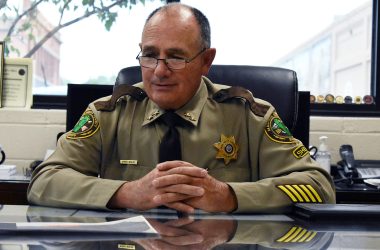 The designation of 2.5 million acres in southeast Oregon as a national monument continues to be pushed by conservationists and opposed by area interests. (Submitted photo)
The designation of 2.5 million acres in southeast Oregon as a national monument continues to be pushed by conservationists and opposed by area interests. (Submitted photo)By Pat Caldwell
The Enterprise
JORDAN VALLEY — The man in the White House will decide Rancher Elias Eiguren’s future on rangelands of Malheur County.
The fifth-generation cattleman can only wait to see whether President Obama bends to environmental interests to put 2.5 million acres of the Owyhee Canyonlands into a national monument.
The president has about six weeks – until Jan. 20 – to act. Meantime, there is no indication whether the new Trump administration would consider the matter if Obama didn’t act.
That’s a long waiting game for ranchers such as Eiguren.
“The reality is if it does come along it will be another adversity we must figure out how to continue with,” he said.
No one – not opponents of the proposal and those in favor – know if the president is even pondering such a move for the Owyhee Canyonlands. His Interior secretary, Sally Jewell, earlier this year told Congress her agency wasn’t working on any such monument proposal.
But if Obama does act in the last minute, as other presidents have with monuments, Republicans could reverse his decision with an obscure legislative mechanism – the Congressional resolution of disapproval.
There is no doubt in Eiguren’s mind what the monument designation would mean for his ranch.
“We’d have to cut our herd to less than half,” Eiguren said. “It would affect where we graze our cattle six months out of the year. Basically, it will encompass nearly 100 percent of our grazing permits,” he said.
Eiguren said a monument designation will force him to find a different place to graze his cattle.
Eiguren said now his ranch utilizes about 3,000 acres of private land, 600 to 700 acres of irrigated land and 50,000 acres of public land.
“We are looking at 50,000 acres being put into jeopardy and we’d have to rely on private property to run our cattle,” he said.
According to a BLM fact sheet on national monuments, grazing will continue in such an area, subject to the same management guidelines for other areas.
Eiguren doesn’t agree.
“History has shown us, initially yes, they (grazing rights) are grandfathered in. But they make management much more difficult over time and more difficult to continue cattle operations,” he said.
That’s because, Eiguren said, maintaining fences and roads becomes a challenge inside a national monument.
“They make it difficult if not impossible to operate,” he said.
The possibility of the monument designation has hung over Eiguren’s family for months. He is part of the Owyhee Basin Stewardship Coalition, actively campaigning against the monument.
“I see it as a further imposition on our lives by the federal government,” he said.
Eiguren said he believes in conservation. He has to take care of his ground or he will not make a profit. He said important land use decisions should account for concerns of area residents.
“I would like to see local folks have the ability to determine what goes on,” he said.
A complicated proposal
On its face the conservation proposal for the area where Eiguren lives and works is a simple one.
A coalition of environmental groups, citizens and businesses support a blueprint to preserve 2.5 million acres of the Owyhee Canyonlands, either with Congressional action or by a presidential designation under the Antiquities Act.
The effort, though, has been bitterly opposed in Malheur County, where 90 percent of voters in the county voting against the designation in a non-binding referendum.
Just exactly when, or if, President Obama will designate the area a national monument remains a mystery.
“We have no idea,” said Andy Bentz, secretary of the Owyhee Basin Stewardship Coalition.
Dan Morse, conservation director for the Oregon Natural Desert Association, a proponent of the conservation effort – said his group wouldn’t predict the fate of the designation and wouldn’t discuss its contacts with the Obama administration. The group supports the monument designation.
“We have highlighted the threats and the value of the Owyhees. I don’t think we can speculate on behalf of the administration about what it will or won’t do,” Morse said.
The canyonlands issue is unique, said Bentz.
“There is only one human making that decision,” Bentz said.
Ryan Frank of the Gallatin Group, a public relations firm working for the Owyhee Basin Stewardship Coalition, said the Owyhee proposal is interesting in another way.
“There is no transparency about what is actually happening,” he said.
Frank said there isn’t the public process usual in most government land decisions.
“If someone is going to site a gas station in Jordan Valley there would be a public process, permitting, a public hearing, some opportunity for the public to know,” he said.
That isn’t the case now for the canyonlands, he said.
“You have an audience of one. And you are not sure what exactly is happening because there is no defined process for how decisions are made,” he said.
Frank said there is no way to accurately judge whether the election of Donald Trump will make any difference in the ongoing debate over the canyonlands.
“I mean, who knows? Because there is no transparency in the process it is hard to tell. So, you just don’t know,” he said.
Nullifying act
If the president does designate the canyonlands a national monument, Congress has a way to reverse the decision, said state Sen. Ted Ferrioli, R-John Day.
He said that on a recent trip to Washington he learned from Senate Majority Leader Mitch McConnell about the little-known resolution of disapproval.
“It can lock back an executive order,” Ferrioli said. Ferrioli said such tool could be critical for opponents if the canyonlands get monument status.
Such a resolution must pass Congress and be signed into law by the president.



